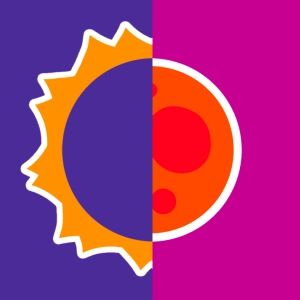 Solar Eclipse 3D
Solar Eclipse 3D
Learning objectives
- To Illustrate the real distances and proportions of the Sun-Earth-Moon system.
- To teach why solar eclipses phenomenon are so exceptionnal;
This scale representation of the Sun-Earth-Moon system illustrates the vast emptiness that separates these three stars.
- Sun: 1.4 million km in diameter;
- Earth: 13,800 km, i.e. 1% of the Sun);
- Moon: 3,400 km, i.e. 1/4 of the Earth and 1/400 of the Sun.
- Sun-Earth distance (also known as the "astronomical unit"): 150 million km (100 suns or 8 minutes at the speed of light);
- Earth-Moon distance: 384,000 km (just over 1 second at the speed of light). We can fit more than 3 Earth-Moon orbits into one diameter of the Sun!
Note that the Sun's diameter (1.4 million km) is 400 times greater than the Earth-Moon distance (384,000 km). As the Moon's diameter is 400 times smaller than that of the Sun, the Moon's apparent diameter in the sky is the same as that of the Sun as seen from Earth. It's this prodigious coincidence that makes a total solar eclipse exceptional. The eclipse phenomenon exists on other planets (see photos of the solar eclipse caused by Io on Jupiter in 2019), but the Earth is in the perfect position to observe the solar corona overflowing the solar disk during a total eclipse.
Another way to visualize these distances and proportions is to consider the Sun as a large grapefruit (14 cm). The Earth would then be a 1.2 mm grain of sand 15 m away! In other words, not visible from the grapefruit.
These values help explain why the alignment between the Sun, Earth and Moon during a solar eclipse is such an exceptional phenomenon; especially if we consider that the plane in which the Earth and the Moon orbit is not in the plane in which Earth and Sun orbit (also known as the ecliptic). This inclination (5°) means that when the Moon passes between the Earth and the Sun, it is sometimes above or below the ecliptic. As a consequence, its shadow will pass above or below the Earth without causing any eclipse.
Photos Credits: Galaxy: ESO/S. Brunier; Sun: NASA JPL; Moon: NASA's Scientific Visualization Studio; Earth: http://planetpixelemporium.com/planets.html

Discover EduMedia for free
The interactive encyclopedia that brings science and math to life in the classroom.
Over 1,000 resources





